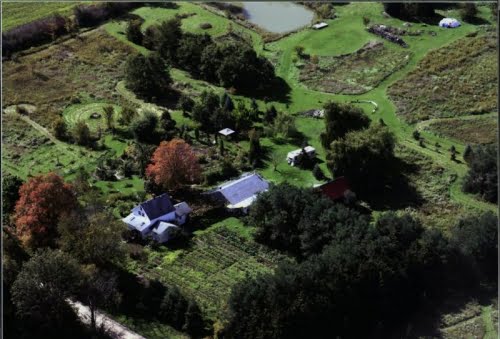Note: this profile was written in 2009, though the information is still largely up to date.
Spirit of the Earth, The Living Centre & Living Arts Institute, founded in 1983, is an eco-spiritual education sanctuary in the countryside near London, Ontario.
A place where edible gardening and aesthetics are intertwined, The Living Centre has a far-reaching vision of sustainability, natural beauty, and responsibility to future generations. The centre includes herb gardens, vegetable gardens, forest gardens, orchards, a cherry grove, and an edible medicine trail, all grown veganically.
The Living Centre (www.thelivingcentre.com) is run by Shantree Kacera and Lorenna Bousquet-Kacera. Their educational programs are aimed at holistic human development, with teachings that promote peace, spiritual growth, physical and emotional health, and eco-sustainability. They teach and practice bioregionalism, deep ecology, and permaculture. Shantree is an author and an Ayurvedic Medicine Practitioner, and has a doctorate in Nutritional Medicine and Herbalism. His teachings include live-food nutrition, herbalism, and forest gardening. Lorenna is a Certified Ayurvedic Living Nutrition Educator and a Creativity Coach, teaching Shamanu, living nutrition, primorial movement, and inner healing.
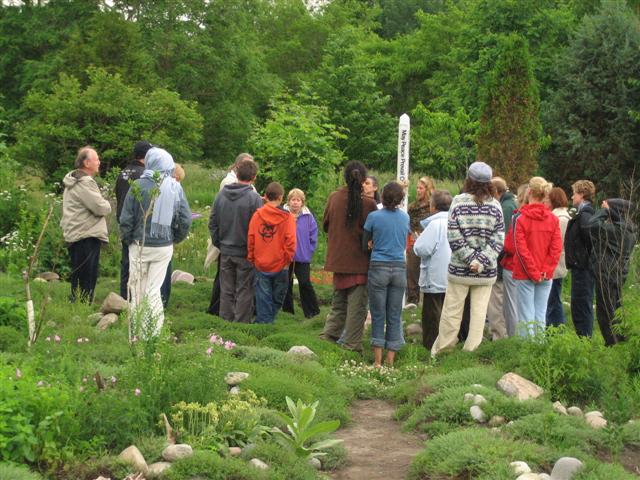
The grandson of an herbalist, Shantree has been an avid gardener since he was a child, and moved to the countryside as a young man in his desire to return to nature. The lands he purchased have always been free of pesticides and chemicals. Shantree previously grew organic vegetables as a business, and at one time was the largest distributor of organic garlic in Ontario and Quebec. Realizing that his true interest is in teaching, he changed the focus from commercial growing to developing an education centre. Over the years, he nurtured the land and developed a centre that is visited internationally by students. A large portion of the centre’s food is grown in their gardens and orchards, and all meals are live-food, vegan, and organic.
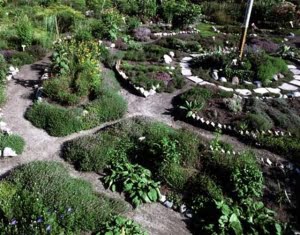 The 50-acre sanctuary is largely made up of meadows and forests, with about 5 acres set aside to be cultivated. The gardens have incredible diversity. Over 500 species of herbs and edible medicinal plants are grown in the Sacred Medicine Wheel Herb Garden, and over 1,000 species of edible and medicinal plants are found at The Living Centre. Their passive solar greenhouse, an earthship made from tires and earth, provides the centre with fresh produce for 9 months a year.
The 50-acre sanctuary is largely made up of meadows and forests, with about 5 acres set aside to be cultivated. The gardens have incredible diversity. Over 500 species of herbs and edible medicinal plants are grown in the Sacred Medicine Wheel Herb Garden, and over 1,000 species of edible and medicinal plants are found at The Living Centre. Their passive solar greenhouse, an earthship made from tires and earth, provides the centre with fresh produce for 9 months a year.
The gardens are mulched with local amendments of straw, hay, sawdust, woodchips, and leaves, to protect the soil, retain water, and feed the microorganisms. The Living Centre maintains sizeable compost piles, and they also make regular batches of nettle tea, kelp tea and comfrey tea.
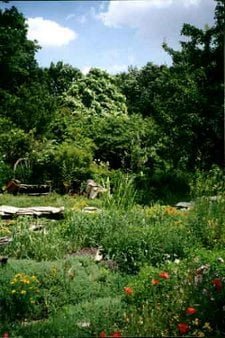
They are currently establishing forest gardens, with the long term aim of having gardens that are largely self-sufficient and that have a wide ranging positive impact on the environment. Forest gardening is done in 3-dimensions, creating biodiverse ecosystems that incorporate fruit and nut trees with shrubs, vines, herbs, root vegetables, ground cover, and fungi. When fully thriving, forest gardens can become self-fertilizing, self-mulching, and self-perpetuating, and able to retain water and nutrients. The key to forest gardening is to mimic nature—gardening becomes easier, says Shantree, when we work with nature and allow the natural processes to do much of the work for us.
Shantree sees forest gardening as a long term vision, a positive way to interact with future generations, the place where agriculture and ecology meet. Whereas annual plants require frequent tending and quick nutrients, The Living Centre is incorporating more perennial plants, which become resilient and self-reliant with time, drawing up nutrients with their deep roots while improving soil structure. As perennial plants and trees may be present for decades, Shantree feels that this allows us to develop a personal relationship with the plants.
To help other aspiring forest gardeners, Shantree has written this description of how they established forest gardens at the Living Centre, from the site assessment to selecting plants.
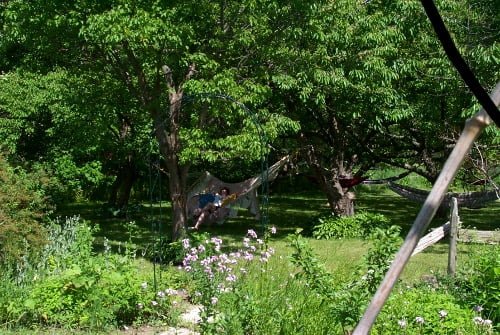
The Living Centre offers courses, workshops, and events, including temperate forest gardening workshops, permaculture design courses, herb walks, and mentorship programs.
Shantree gardens veganically “for every reason under the sun”. With a love for animals, he would rather see animals thrive in the wild than be domesticated. He also finds that working directly with plants is simpler and more efficient than involving farmed animals in the system. Shantree says that the way you garden is the way you view the world—it reflects a mindset. Concerned about our society’s rapid loss of topsoil, Shantree views himself not as simply a grower of plants, but as a grower of healthy soil, aiming to replenish the fertility and long-term viability of the lands that they tend.
